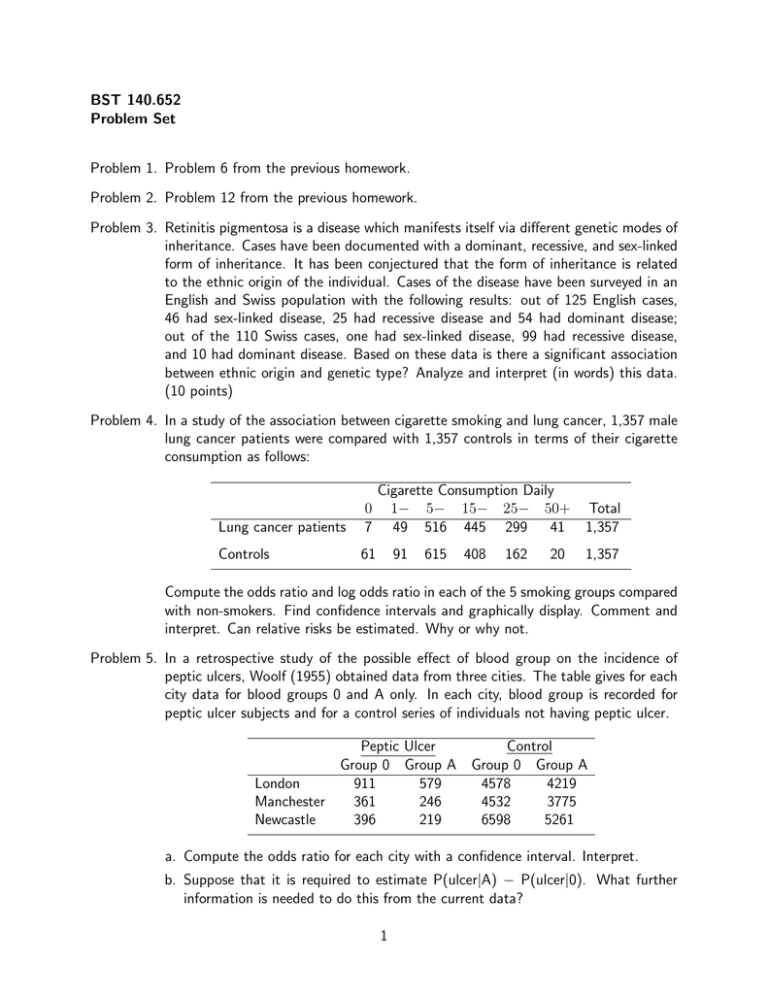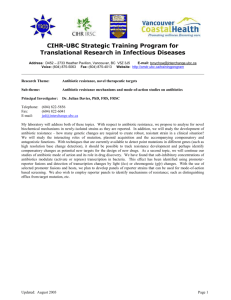BST 140.652 Problem Set Problem 1. Problem 6 from the previous
advertisement

BST 140.652 Problem Set Problem 1. Problem 6 from the previous homework. Problem 2. Problem 12 from the previous homework. Problem 3. Retinitis pigmentosa is a disease which manifests itself via different genetic modes of inheritance. Cases have been documented with a dominant, recessive, and sex-linked form of inheritance. It has been conjectured that the form of inheritance is related to the ethnic origin of the individual. Cases of the disease have been surveyed in an English and Swiss population with the following results: out of 125 English cases, 46 had sex-linked disease, 25 had recessive disease and 54 had dominant disease; out of the 110 Swiss cases, one had sex-linked disease, 99 had recessive disease, and 10 had dominant disease. Based on these data is there a significant association between ethnic origin and genetic type? Analyze and interpret (in words) this data. (10 points) Problem 4. In a study of the association between cigarette smoking and lung cancer, 1,357 male lung cancer patients were compared with 1,357 controls in terms of their cigarette consumption as follows: Lung cancer patients Cigarette Consumption Daily 0 1− 5− 15− 25− 50+ Total 7 49 516 445 299 41 1,357 Controls 61 91 615 408 162 20 1,357 Compute the odds ratio and log odds ratio in each of the 5 smoking groups compared with non-smokers. Find confidence intervals and graphically display. Comment and interpret. Can relative risks be estimated. Why or why not. Problem 5. In a retrospective study of the possible effect of blood group on the incidence of peptic ulcers, Woolf (1955) obtained data from three cities. The table gives for each city data for blood groups 0 and A only. In each city, blood group is recorded for peptic ulcer subjects and for a control series of individuals not having peptic ulcer. Peptic Ulcer Group 0 Group A London 911 579 Manchester 361 246 Newcastle 396 219 Control Group 0 Group A 4578 4219 4532 3775 6598 5261 a. Compute the odds ratio for each city with a confidence interval. Interpret. b. Suppose that it is required to estimate P(ulcer|A) − P(ulcer|0). What further information is needed to do this from the current data? 1 Problem 6. Suppose we wish to compare two treatments for breast cancer, viz., simple mastectomy (S) and radical mastectomy (R). We form matched pairs of women who are within the same decade of age and with the same clinical condition to receive the two treatments and measure their 5-year survival. The results are given (L=lived at least 5 years, D=died within 5 years) below. Perform an analysis of this data, and interpret your results. Pair 1 2 3 4 5 6 7 8 9 10 Treatment S Person L L L L L D L L L L Treatment R Person L D L L L L L D D L Pair 11 12 13 14 15 16 17 18 19 20 Treatment S Person D L L L L L L L L L Treatment R Person D D L L D L D D L D Problem 7. Suppose we are interested in comparing the effectiveness of 2 different antibiotics A and B in treating gonorrhea. We match each person receiving antibiotic A with an equivalent person (age within 5 years, same sex) to whom we give antibiotic B and we ask that these persons return to the clinic within 1 week to see if the gonorrhea has been eliminated. Suppose the results are as follows: For 40 pairs of people both antibiotics are successful. For 20 pairs of people antibiotic A is effective while antibiotic B is not. For 16 pairs of people antibiotic B is effective while antibiotic A is not. For 3 pairs of people neither antibiotic is effective. Perform an analysis to compare the relative effectiveness of the two antibiotics. Interpret your results. Problem 8. Consider a retrospective study with matched pairs. Show that McNemar’s test statistic is equivalent to performing a Mantel-Haenszel test for all 2 × 2 tables (with one table for each pair). 2


